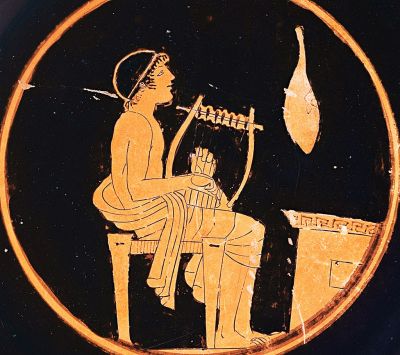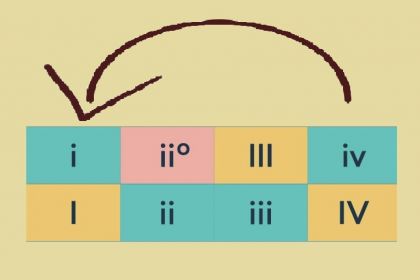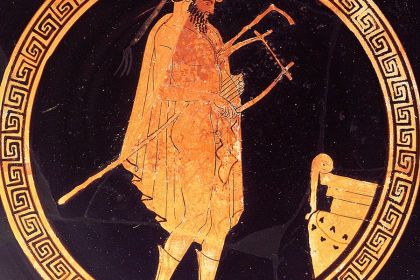Music Theory
8 songs to introduce Aeolian mode and natural minor scale

Terracotta Kylix Attributed to the Akestorides Painter
Over the past centuries, the composition of polyphonic music has been primarily focused on seven diatonic scales traditionally named after the geographical regions of Ancient Greece: Ionian, Dorian, Phrygian, Lydian, Mixolydian, Aeolian, and Locrian. Musical modes rooted in these diatonic scales all share optimal interval patterns which allow the organization of melodies in a horizontal harmony and the formation of accompanying chords in a vertical harmony.
The vast majority of compositions, whether in classical or popular music, are written in the Ionian major mode and Aeolian mode, better known as the natural minor mode. Music theory explains that this choice ideally provides any piece with both the polyphonic structure and the interaction of diatonic functions, the alternation of which creates tension and resolves it.
A characteristic feature of the natural minor scale is the seventh scale degree, which is a whole tone away from the first degree. In other words, the scale does not contain the leading-tone and so the Aeolian mode is devoid of the most important perfect authentic cadence. On the other hand, the Aeolian seventh scale degree—called the subtonic—provides a convenient opportunity for the downward movement of melody from the first to the fifth scale degree.
C Aeolian scale:


The Aeolian mode is classified as a minor one due to the tonic triad being built on the first scale degree and forming a minor chord. Two more minor chords in the Aeolian mode are rooted in the fourth and fifth degrees, while the major triads can be built on the third, sixth, and seven degrees. For example, C Aeolian mode contains the following triads denoted below according to the rules of harmonic analysis in which major chords are marked with uppercase Roman numerals and minor chords with lowercase Roman numerals: i–Cm, iio–Ddim, III–E, iv–Fm, v–Gm, VI–A, VII–B♭.
The analysis of C Aeolian mode through the Roman numeric system:


A great example of a simple yet energetic chord progression written in C♯ Aeolian is found in All Along The Watchtower released by Bob Dylan in 1967. The entire song is laid out against the background of only one looped sequence revealing the undoubted convenience of the natural minor mode allowing a stepwise movement of the triads rooted in the first, seventh, and sixth scale degrees in both directions: C♯m–B–A–B or i–VII–VI–VII.
Listen to All Along The Watchtower by Bob Dylan:
Another example of a simple harmony written in D Aeolian appears in the 1981 track If I Was A Blackbird by Silly Wizard. The song's intro is based on the repeating minor authentic cadence, and the verses feature the fifth-degree dominant Am chord where it is resolved into the tonic Dm chord via the subtonic dominant C chord:
- Dm–Am or i–v for the intro
- Dm–Am–C–Dm or i–v–VII–i for verses
It is noteworthy that the subdominant function is not represented here since these progressions do not contain any chords of the subdominant family iio, iv, VI.
Listen to If I Was A Blackbird by Silly Wizard:
An interesting application of A Aeolian is found in both chord progressions of Red Hot Chili Peppers' Dani California:
- Am–G–Dm–Am or i–VII–iv–i for verses
- F–C–Dm–G or VI–III–iv–VII for choruses
The verses contain an example of the Dm–Am minor plagal cadence used to close each pair of rhymed lines. In the chorus progression, chords are combined in such a way that the tonic triad does not appear at all, creating a certain degree of tension which is then resolved by the Am chord at the start of each verse.
Listen to Dani California by Red Hot Chili Peppers:
Well-developed E Aeolian sequences that contain both the triads and seventh chords can be heard in the 1963 track Not A Second Time by The Beatles. In the verses, the alternation of the triads G–Em, rooted in the third and first scale degrees, creates a sense that the song is written in G major key due to the fact that a relative major scale starts exactly on the third degree of a natural minor scale:
- G–Em–G–Em–D–G–D7 or III–i–III–i–VII–III–VII7
- G–Em–G–Em–D–Am7–D7 or III–i–III–i–VII–iv7–VII7
Two more progressions, appearing in all choruses and the solo, demonstrate the juxtaposition of the subdominant and dominant diatonic functions in a rather typical manner often found in classical music:
- Am7–Bm7–G–Em or iv7–v7–III–i
- Am–Bm–D7–Em or iv–v–VII7–i
The instances in which the dominant fifth-degree Bm chord follows strictly after the subdominant fourth-degree Am chord see the creation of strong tension, generating the expectation that practically any chord of the tonic function may follow suit. In the first line, the tension is resolved by the third-degree G triad, while in the second line the seventh-degree D7 chord expands the dominant function to establish the tonic Em triad at the end of the musical phrase.
Listen to Not A Second Time by The Beatles:
Listen to Not A Second Time by The Beatles:
Katy Perry's 2012 number one hit Part Of Me is a clear example of how a song written in the natural minor mode uses primary chords of the relative Ionian major mode. All sections of the song are based on three A Aeolian progressions:
- Am–C–F or i–III–VI
- Am–C–F–G or i–III–VI–VII
- Am–C–G or i–III–VII
It is easy to see that only the tonic Am triad is a minor chord while the rest of the song chords give an illusion that the piece is written in the relative C major key. Moreover, by assuming the C as the tonal center, the rest of the chords can be interpreted as the subdominant F chord, dominant G chord, and sixth scale degree Am chord.
Listen to Part Of Me by Katy Perry:
Another similar example of using major chords of the relative Ionian mode in the natural minor piece is revealed by the 1979 glam rock track I Was Made for Loving You by Kiss written in E Aeolian:
- Em–G–D–Em–G–D–C or i–III–VII–i–III–VII–VI for verses
- Em–Am–Em–Am–Em–D or i–iv–i–iv–i–VII for choruses
In the verses, along with the tonic Em chord, all three primary chords of the relative G major key are used. The choruses feature the repetitive minor plagal cadence Am–Em refreshed by the closing subtonic D chord.
Listen to I Was Made for Loving You by Kiss:
Released in 1983, The Trooper by Iron Maiden is written in E Aeolian and shows an advanced musical form that implies separate harmonic progressions for each section which is not at all unusual for metal and related rock genres:
- Em–D–C–D or i–VII–VI–VII for intro and outro
- Em–D–Em–D–C–D–Em–D or i–VII–i–VII–VI–VII–i–VII for verses
- D–Em–D or VII–i–VII for choruses
- Em–D–Em–D–C–F–D or i–VII–i–VII–VI–♭II–VII for bridges
All song sections are also dominated by major chords with the exception of the Em minor tonic chord. Here, the F chord seen in the bridge does not belong to the natural minor mode since the E Aeolian supertonic triad is the diminished F♯0 chord. However, a major chord built on the ♭II lowered second degree, known as the Neapolitan chord of the Phrygian mode, sometimes occurs in the natural minor mode. The final phrase of the solo section also features the Neapolitan chord:
- Em–D–Bm–C–D or i–VII–v–VI–VII
- Am–G–Em–F–G or iv–III–i–♭II–VII
Listen to The Trooper by Iron Maiden:
R.E.M.'s absolutely iconic 1991 single Losing My Religion combines chords of A Aeolian in a very diverse way:
- F–Dm–G–Am or VI–iv–VII–i for intro
- F–Dm–G–Am–G or VI–iv–VII–i–VII for intro
- Am–Em–Am–Em–Am–Em–Dm–G or i–v–i–v–i–v–iv–VII for verses
- G–F–Dm–G–Am–F–Dm–G–Am–G or VII–VI–iv–VII–i–VI–iv–VII–i–VII for bridges
It is noteworthy how the subtonic G chord closes each sequence thereby forming a cadence.
Listen to Losing My Religion by R.E.M.:
As a major chord representing the dominant function, the subtonic triad truly refreshes the ending phrases—evident in the last example—although in many cases, a major triad rooted in the fifth degree participates in cadences of the Aeolian mode V–i. This means that the seventh scale degree is raised by a semitone—in other words, the subtonic turns into the leading-tone thereby creating the harmonic minor scale.
Discover more songs composed in Aeolian minor mode and check out their harmonic analysis in the following articles:
- 6 songs combining harmonic minor and Aeolian mode
- I Shot the Sheriff: Burnin' spliff nearly destroyed Bob Marley's original recording
- Mariposa Traicionera: meaning and flamenco roots of Maná's top hit
- Livin' la Vida Loca: why is Ricky Martin's best song so catchy?
- Locomotive Breath: fine groove born from Jethro Tull's studio session
- Shaman's Blues: quintessential The Doors song refined their most controversial album
- A Dios le Pido: Juanes' Spanish lyrics behind the song success
- El Farsante and 7 more songs by Ozuna in Dorian and Aeolian modes



